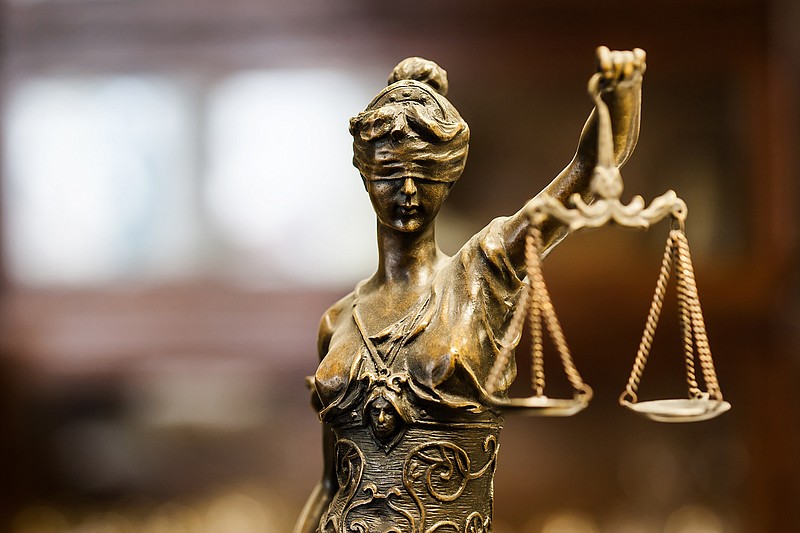WASHINGTON -- Goldman Sachs Group asked the U.S. Supreme Court on Monday to overturn a federal court ruling that cleared the way for a securities fraud class action lawsuit to advance.
An attorney for the Arkansas Teacher Retirement System and other investors argued that the case had been rightly decided and should be upheld.
Oral arguments for Goldman Sachs Group v. Arkansas Teacher Retirement System occurred telephonically, rather than in the high court's chambers, because of the covid-19 pandemic.
Goldman Sachs is one of the world's largest banking, wealth management and financial services firms.
The retirement system has assets of roughly $20 billion; it is Arkansas' largest public pension fund.
Attorney Kannon Shanmugam, representing Goldman Sachs, argued that the Second U.S. Circuit Court of Appeals had erred by upholding certification of a class-action lawsuit "based on exceptionally generic and aspirational statements in the face of overwhelming and unrebutted evidence that the statements had no impact on the stock price."
The appeals court, he said, incorrectly refused to consider "the generality of the statements as evidence tending to disprove price impact."
The lower court also erred by shifting the "burden of persuasion" regarding changes in the stock price to Goldman Sachs instead of the investors, he said.
Justice Samuel Alito asked Shanmugam if there were limits on the types of company statements that could be grounds for a class-action lawsuit.
"Suppose the company says we are a nice company. Would you say that a court could not say that statement is so bland and innocuous that there cannot be reliance [on it]?" Alito said.
In that scenario, Shanmugam said, "There is a familiar and massive body of case law that says that statements of that variety are immaterial as a matter of law."
Attorney Thomas C. Goldstein, representing the retirement system and other investors, said that on one key issue, "there is no difference between the parties and the United States. We agree with them that the generic nature of the statement as they used the term is relevant evidence to price impact," he said.
The Second U.S. Circuit Court of Appeals had done precisely that, he said.
If there is some ambiguity in how the court reached its final determination, "you can resolve that just by making clear how you understand the court [to have ruled]," Goldstein said.
The burden of persuasion, he maintained, should remain with Goldman Sachs.
Justice Stephen Breyer questioned how deeply the court should wade into the complex case.
"This seems like an area that, the more I read about it, the less that we write, the better," he said.
The litigation in question has already been going for nearly a decade.
In its suit, the Arkansas Teacher Retirement System alleges that Goldman Sachs made false statements about its business practices, causing harm to investors.
Goldman Sachs says the suit lacks merit.
In Securities and Exchange Commission filings, annual reports and conference calls between 2006 and 2010, Goldman Sachs told investors that:
• "[W]e have extensive procedures and controls that are designed to identify and address conflicts of interest."
• "We are dedicated to complying fully with the letter and spirit of the laws, rules and ethical principles that govern us. Our continued success depends upon unswerving adherence to this standard."
• "Integrity and honesty are at the heart of our business."
Those claims were called into question by the retirement system and others, after Goldman Sachs ran afoul of the SEC.
On April 16, 2010, the SEC brought a securities fraud action against Goldman Sachs, alleging the company had misled investors about an investment instrument that plummeted in value during the 2007-8 financial crisis.
Eventually, Goldman Sachs agreed to pay a $550 million fine after admitting that it had provided investors with "incomplete information" about the deal's origins.
Goldman Sachs stock, which was trading at $184.27 on April 15, fell to $160.70, the day the SEC took action. That represented a roughly $13 billion drop in shareholder value, the retirement system said.
Soon after, Goldman Sachs was sued by the Arkansas retirement system, the West Virginia Investment Management Board and the Plumbers and Pipefitters National Pension Fund.
U.S. District Judge Paul A. Crotty in New York has already certified the class, clearing the way for the case to proceed. A panel of the Second U.S. Circuit Court of Appeals, in a 2-1 ruling, upheld the most recent ruling by Crotty, who was placed on the bench by then-President George W. Bush.
Judge Richard C. Wesley, another Bush appointee, and Judge Denny Chin one of then-President Barack Obama's nominees, sided with the retirement system.
Judge Richard Sullivan, appointed by then-President Donald Trump, dissented.
The U.S. Department of Justice, which also participated in Monday's hearing, hasn't sided with either party in the case.
In a friend of the court brief "supporting neither party," the agency argued that defendants "may rely on the generic nature" of alleged misstatements as evidence the statements "had no actual price impact."
The fact that the statement is generic, on the other hand, is not enough, on its own, to resolve the matter, the department said.
